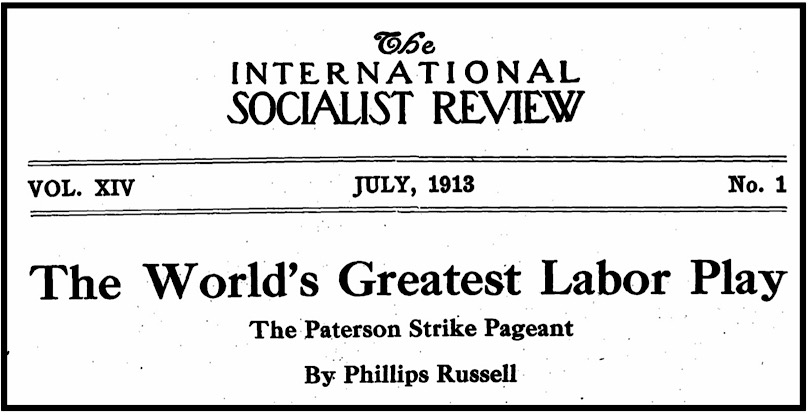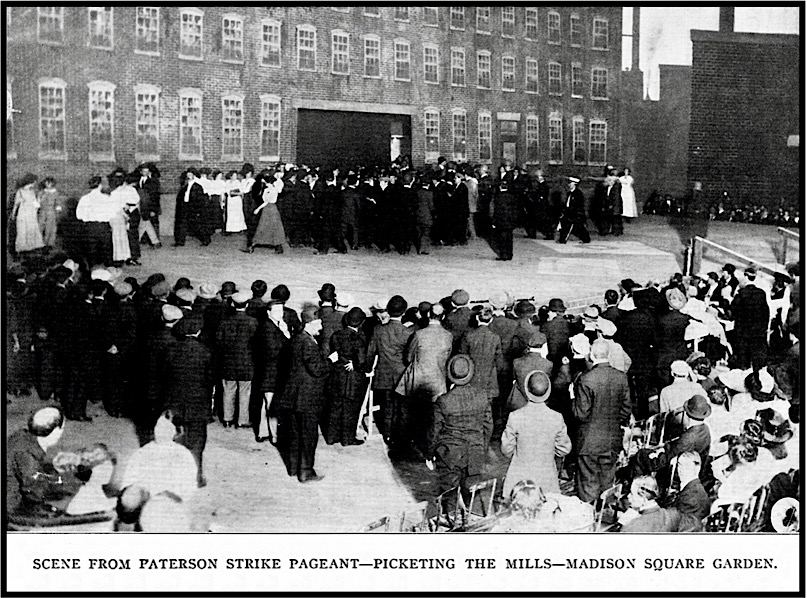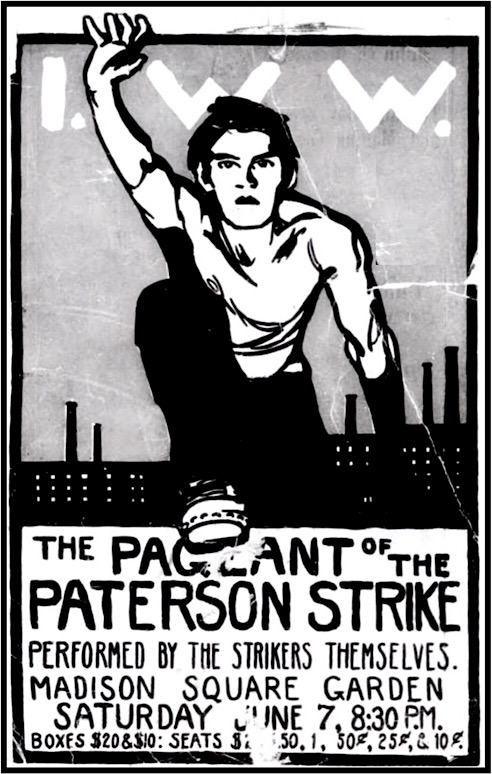 —————
—————
Hellraisers Journal – Tuesday July 1, 1913
“The Paterson Strike Pageant” by Phillips Russell, Part I
From the International Socialist Review of July 1913:
[Part I of II]
JUNE 7, 1913, was a red letter day in New York. Literally, too. For when dusk fell on Madison Square, high up on the tower of Madison Square Garden, shone the giant letters “I. W. W.,” glowing red in the sky and sending scarlet beams through the smoke that drifts incessantly across the face of Manhattan Island.
It was the first time that those significant letters have ever been given so conspicuous a place. Their mission was to announce something new under the sun, a labor play in which laborers themselves were the actors, managers and sole proprietors, portraying by word and movement their own struggle for a better world.
Imagine a great auditorium, the largest in New York, filled with one of the hughest audiences that ever gathered in the metropolis, gazing on the largest amateur production ever staged, with the biggest cast-1,029 members-that ever took part in a play, enacting a life-drama calculated to raise to the highest pitch the most powerful human emotions-and one gets a faint idea of the event in Madison Square Garden on the evening of June 7.
In order to give the reader a mental picture of what happened that night on the stage-which alone cost $600 to build -it might be well to outline the six episodes composing the pageant as given in the official program, which itself made a good propaganda pamphlet of 32 pages with a lithographed cover:
Scene: Paterson, N.J. Time: A. D. 1913.
The Pageant represents a battle between the working class and the capitalist class conducted by the Industrial Workers of the World (I. W. W.), making use of the general strike as the chief weapon. It is a conflict between two social forces-the force of labor and the force of capital.
While the workers are clubbed and shot by detectives and policemen, the mills remain dead. While the workers are sent to jail by hundreds, the mills remain dead. While organizers are persecuted, the strike continues, and still the mills are dead. While the pulpit thunders denunciation and the press screams lies, the mills remain dead. No violence can make the mills alive-no legal process can resurrect them from the dead. Bayonets and clubs, injunctions and court orders are equally futile.
Only the return of the workers to the mills can give the dead things life. The mills remain dead throughout the enactment of the following episodes.
EPISODE ONE.
1. The Mills Alive-The Workers Dead.
2. The Workers Begin to Think.Six o’clock on a February morning. The mill windows all aglow. The mill whistle sounds the signal to begin work. Men and women, old and young, come to work in the bitter cold of the dawn. The sound of looms. The beginning of the great silk strike. The striking workers sing the Marseillaise, the entire audience being invited to join in the song of revolt.
EPISODE TWO.
The Mills Dead-The Workers Alive.Mass picketing. Every worker alert. The police interfere with peaceful picketing and treat the strikers with great brutality. The workers are provoked to anger. Fights between police and strikers ensue. Many strikers are clubbed and arrested. Shots are fired by detectives hired by the manufacturers, and Valentino Modestino, who was not a striker or a silk mill worker, is hit by a bullet and killed as he stands on the porch of his house with one of his children in his arms.
EPISODE THREE.
The Funeral of Modestino.The coffin containing the body of Modestino is followed by the strikers in funeral procession to the strains of the Dead March. The strikers passing drop red carnations and ribbons upon the coffin until it is buried beneath the crimson symbol of the workers’ blood.
EPISODE FOUR.
Mass Meeting at Haledon.Great mass meeting of 20,000 strikers. I. W. W. organizers speak. Songs by the strike composers are sung by the strikers. They also sing the International, the Marseillaise and the Red Flag, in which the audience is invited to join.
EPISODE FIVE.
1. May Day.
2. Sending A way the Children.The May Day Parade. The workers of Paterson, with bands playing, flags flying, and women and children dressed in red, celebrate the international revolutionary labor day.
The strikers give their children to the “strike mothers” from other cities. The strike mothers receive them to be cared for during the war in the silk industry. Elizabeth Gurley Flynn speaks to the strikers and the children, dwelling upon the solidarity of labor shown in this vividly human episode, and is followed by William D. Haywood.
EPISODE SIX.
Strike Meeting in Turn Hall.The strikers, men and women, legislate for themselves. They pass a law for the eight-hour day. No court can declare the law thus made unconstitutional. Elizabeth Gurley Flynn, Carlo Tresca and William D. Haywood make typical strike speeches.
[Emphasis added.]
~~~~~~~~~~~~~~~~~~~~~~~~~
SOURCES & IMAGES
Quote BBH, IU=Socialism w Working Clothes On,
NYC Cooper Union Debate w Hillquit, Jan 11, 1912
-Sum of Jan 11 Debate w Hillquit fr NY Call p1, Jan 12
https://www.marxists.org/history/usa/pubs/the-new-york-call/1912/120112-newyorkcall-v05n012.pdf
-Source for Quote is Jan 14 Sunday Call, Stenographic Report, per:
https://books.google.com/books?id=ili0huEKAk0C&pg=PA389&dq=hillquit+haywood+debate&hl=en&newbks=1&newbks_redir=0&sa=X&ved=2ahUKEwjw2s37lI_4AhWVg3IEHdjEAa0Q6AF6BAgEEAI#v=onepage&q=%22hillquit-Haywood%20debate%22&f=false
International Socialist Review
(Chicago, Illinois)
-July 1913, page 7
https://www.marxists.org/history/usa/pubs/isr/v14n01-jul-1913-ISR-riaz-ocr.pdf
See also:
Pageant of the Paterson Strike, Madison Square Garden,
Saturday, June 7th, 8.30 P.M
-by F. Boyd
NY Success Press, 1913
https://archive.org/details/pageantofpaterso00unse/page/n4/mode/1up?view=theater
“Paterson Silk Strike, 1913″ by Catherine A. Paul
https://socialwelfare.library.vcu.edu/organizations/labor/paterson-silk-strike-1913/
Tag: Paterson Pageant 1913
https://weneverforget.org/tag/paterson-pageant-1913/
Tag: Paterson Silk Strike of 1913
https://weneverforget.org/tag/paterson-silk-strike-of-1913/
~~~~~~~~~~~~~~~~~~~~~~~~~



